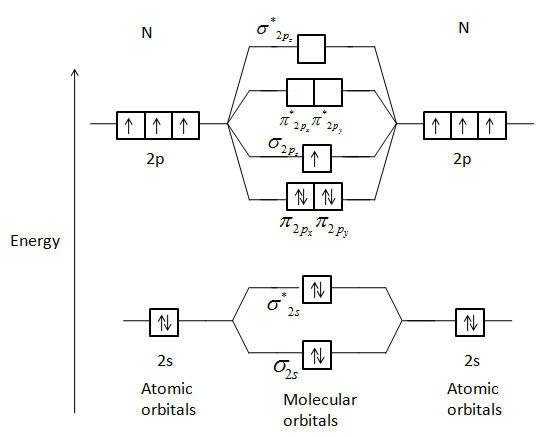
Draw the molecular orbital diagram for the formation of $ N_{2}^{+} $ ion. Calculate the bond order and describe its magnetic behavior.
Answer
498.9k+ views
Hint: We know that generally the molecular orbital diagrams are used to understand the bonding of a diatomic molecule. You should know that molecular orbital diagrams are used to deduce magnetic properties of a molecule; they also help us to find out the bond order of the molecule.
Complete Step By Step Solution :
First, let us understand the concept of molecular orbital theory. On a very general basis, electrons are not assigned to individual bonds between atoms, but they move under the influence of the nuclei in the whole molecule. Molecular orbital theory is a method for describing the electronic structure of the molecule.
As we know the electron has an electron magnetic dipole moment, which is generally generated by the electron’s spin property, which induces an electric charge into motion. As we can see the term “magnetic” refers to the magnetic dipole. There are many types of magnetic behavior which are paramagnetic, diamagnetic and ferromagnetic. Bond order: In simple words, it can be stated that bond order is the difference between the number of bonds and antibonds. Bond number also gives an indication of the stability of a bond.

When two atomic orbitals combine they form two new molecular orbitals, one by the additive effect of the atomic orbitals which is called the bonding molecular orbital and the other is formed by the subtractive effect of the atomic orbitals which is called the antibonding molecular orbital.
Note:
Remember that you should generally know that the electron probability distribution around a nucleus in an atom is given by an atomic orbital; likewise the electron probability distribution around a group of nuclei in a molecule is given by a molecular orbital diagram.
Complete Step By Step Solution :
First, let us understand the concept of molecular orbital theory. On a very general basis, electrons are not assigned to individual bonds between atoms, but they move under the influence of the nuclei in the whole molecule. Molecular orbital theory is a method for describing the electronic structure of the molecule.
As we know the electron has an electron magnetic dipole moment, which is generally generated by the electron’s spin property, which induces an electric charge into motion. As we can see the term “magnetic” refers to the magnetic dipole. There are many types of magnetic behavior which are paramagnetic, diamagnetic and ferromagnetic. Bond order: In simple words, it can be stated that bond order is the difference between the number of bonds and antibonds. Bond number also gives an indication of the stability of a bond.

When two atomic orbitals combine they form two new molecular orbitals, one by the additive effect of the atomic orbitals which is called the bonding molecular orbital and the other is formed by the subtractive effect of the atomic orbitals which is called the antibonding molecular orbital.
Note:
Remember that you should generally know that the electron probability distribution around a nucleus in an atom is given by an atomic orbital; likewise the electron probability distribution around a group of nuclei in a molecule is given by a molecular orbital diagram.
Recently Updated Pages
Why are manures considered better than fertilizers class 11 biology CBSE

Find the coordinates of the midpoint of the line segment class 11 maths CBSE

Distinguish between static friction limiting friction class 11 physics CBSE

The Chairman of the constituent Assembly was A Jawaharlal class 11 social science CBSE

The first National Commission on Labour NCL submitted class 11 social science CBSE

Number of all subshell of n + l 7 is A 4 B 5 C 6 D class 11 chemistry CBSE

Trending doubts
Differentiate between an exothermic and an endothermic class 11 chemistry CBSE

10 examples of friction in our daily life

One Metric ton is equal to kg A 10000 B 1000 C 100 class 11 physics CBSE

Difference Between Prokaryotic Cells and Eukaryotic Cells

State the laws of reflection of light

Explain zero factorial class 11 maths CBSE




